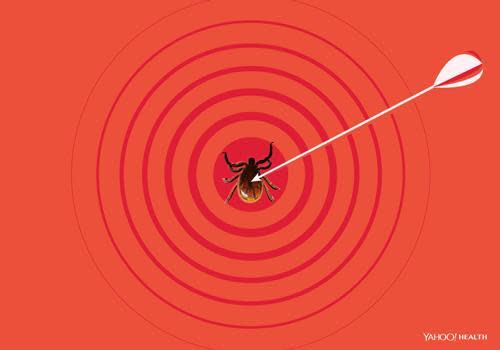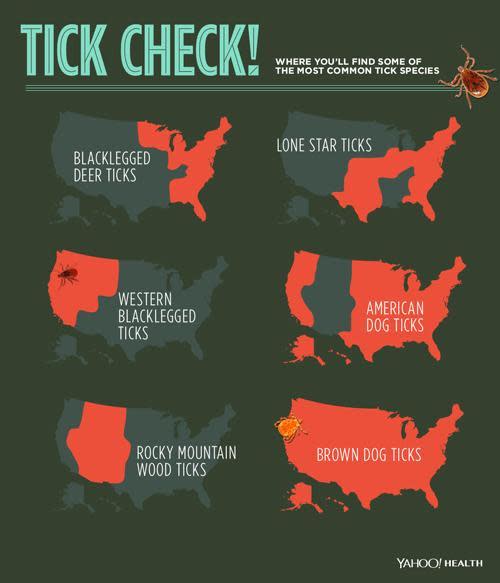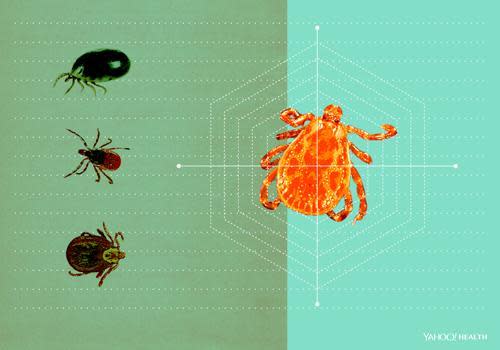Bitten by a Tick? What You Need to Know (and the Diseases to Look Out for)

Lyme isn’t the only tickborne disease out there. (Photo: Erik Mace for Yahoo Health/National Pest Management Association)
A few years back, country music star Brad Paisley released a curious, but successful, single — one that included this line in the main chorus: “I want to check you for ticks.” And he might have been onto something.
This year, more so than others, ticks are abundant, early, and urban. That doesn’t come as a surprise to experts: For the most part, harsh winters lead not only to more appreciated springs, but also an increase in number of the small arachnids.
And while you might be familiar with the types of ticks you’ve pulled off your dog, or heard stories about Lyme disease — the most common tickborne illness — you may not realize that there are almost 900 species of ticks in the world, and a slew of sicknesses associated with each.
“About 10 percent of the 900 tick species can be found in the continental United States,” says Bennett Jordan, PhD, an entomologist and staff scientist for the National Pest Management Association. The most common: the blacklegged deer tick, lone star tick, American dog tick, brown dog tick, and Rocky Mountain wood tick.
What diseases do ticks spread?
While Lyme disease gets most of the ink when it comes to tick diseases, “there are over 10 pathogens known to be vectored by ticks in North America,” says Jordan. And the list has only grown in the past couple of years with the discovery of the Heartland virus: As of March of last year, the Centers for Disease Control and Prevention (CDC) had ID'ed eight cases of the virus, which is a rare condition associated with fatigue, stomach pain, and in one case, death.
Here, Jordan breaks down the more common health threats posed by ticks:
Lyme disease
“Lyme disease is the No. 1 tickborne illness of concern in the United States. There are about 30,000 cases reported annually, with the majority of them occurring in the upper Midwest to northeastern United States,” says Jordan. Blame the blacklegged deer tick and the western blacklegged tick for the disease. When infected, they can transmit a bacterium called Borrelia burgdorferi to humans, says Jordan. But not all ticks of these species carry the Lyme-causing agent.
Symptoms: Look for a bull’s-eye rash around the site of the bite — it happens in about 80 percent of people infected, says Jordan. Just know that the rash can take a few days, and up to a month, to show up after you remove the tick. You also may experience muscle and joint aches, fever, chills, headache, and fatigue, Jordan says. “If unchecked, symptoms worsen and can include Bell’s palsy, meningitis (which can be marked by severe headaches and neck stiffness), pain and swelling in the joints, additional rashes away from the bite site, difficulty sleeping, and even changes in heartbeat,” he says.
Checking yourself is important: “It’s thought that ticks must remain attached for 24 or more hours to transmit the Lyme-causing agent,” Jordan adds. But you’ll have to do a good job looking, as most cases of Lyme show up after a person has been bitten by tiny nymphs, which are supersmall — and thus harder to see.
Related: Avril Lavigne and 6 Other Celebrities Touched by Lyme Disease
Rocky Mountain spotted fever
This is the second-most problematic tickborne illness in this country — and a very serious one. About 2,000 people report cases a year. What it is: “A rickettsial disease (carried by things like ticks, fleas, or lice) caused by bacteria,” Jordan explains. The American dog tick, the Rocky Mountain wood tick, and the brown dog tick can all transmit it. “The American dog tick transmits it in the eastern United States and the Rocky Mountain wood tick in the western U.S.,” he says.
Symptoms: The initial symptom of Rocky Mountain spotted fever is, well, a fever. Also look for a rash, which may be joined by malaise, headaches, chills, and gastrointestinal distress. “The rash is where this fever gets its name, and it usually starts on the extremities and spreads throughout the body. In rare cases, some people do not get a rash,” says Jordan. Go to the doc ASAP if you think you’re suffering: If untreated, Rocky Mountain spotted fever is fatal in 20 percent of cases, says Jordan. But with treatment, death rates drop to less than 1 percent, Amesh A. Adalja, MD, an infectious disease specialist at the University of Pittsburgh Medical Center, tells Yahoo Health.
Powassan virus
Powassan is a very rare tickborne illness transmitted by Ixodes ticks, which include the blacklegged tick that transmits Lyme disease, says Jordan. Unlike Lyme, though, it can be transmitted almost immediately after the bite of an infected tick.
Symptoms: Many people are asymptomatic. Others show signs within a week to a month of being bitten. Look for: fever, confusion, vomiting, difficulty speaking, and general weakness, says Jordan. And take your symptoms seriously! “The virus can disturb the function of the central nervous system and cause both meningitis and encephalitis, which are clearly very serious problems,” says Jordan. He adds that Powassan virus is fatal in 10 percent of cases — and notes that those who survive may also have neurological problems like headaches or memory problems.
Related: Powassan Virus in Connecticut Ticks: Should You Be Worried?
Red meat allergy
Here’s something you might not realize: The bite of the lone star tick can lead to a red meat allergy. “The mechanism isn’t fully understood but it’s believed that a sugar, ‘alpha-gal’ — found in the guts of these ticks and passed to a person during feeding — can trigger a person’s body to react to it and produce antibodies to combat it,” Jordan explains. “However, red meat also contains the same sugar, so when a person with a red meat allergy eats red meat, his or her body reacts the same way, and an allergic reaction takes place.”
Symptoms: You might break out in hives, vomit, have diarrhea, and even go into anaphylactic shock within hours of consuming red meat.
Where do you find each kind of tick?
Not all tick species are the same — some prefer brush and forested areas, while others are found in open fields, scrubland, and along trails. And lately, there has been a reported increase in tick populations around urban centers, especially in the northeast, says Jordan.

(Infographic by Erik Mace for Yahoo Health)
Blacklegged deer ticks: Primarily in the northeastern, mid-Atlantic, southeastern, and north central regions of the U.S.
Western blacklegged ticks: Distributed across the western United States north of Arizona and west of Colorado.
Lone star ticks: Found primarily in west central Texas northward to northern Missouri and eastward from Maine to the southern tip of Florida.
American dog ticks: Found throughout the U.S., except the Rocky Mountains area.
Brown dog ticks: Found throughout the country.
Rocky Mountain wood ticks: Found primarily in the Rocky Mountain states.
Are ticks that feed on dogs different than those that feed on humans?
“The ticks that feed on your dogs are typically the same species that feed on you, though some tick species may have a preference for one or the other,” says Jordan. The American dog tick prefers to feed on your dog but will readily take a bloodmeal from people, and the brown dog tick has a stronger preference for dogs but will bite you if dogs aren’t present, he says. “This species is unique: It can complete its whole life cycle indoors, and infestations can reach massive levels, especially if dogs are an available food source. “
Can you tell ticks apart?
Sure, size and color of the little bloodsuckers offer clues to a tick’s species. But in general, unless you’re a pro — and have some tools handy — you’re going to have a hard time telling which is which, says Jordan. Plus, size and color can vary greatly: “At various stages, ticks can generally be smaller than a poppy seed and up to the size of an apple seed and run the color spectrum from reddish brown to gray,” he says.
Even more: The ladies and gents can look different. “For example, the only species with an easily identifiable feature is the lone star tick, but the white spot on the back of adult females is not present on males,” says Jordan.

Top left tick is an engorged blacklegged deer tick, middle left tick is a female blacklegged deer tick, bottom left tick is an American dog tick. (Photo: Erik Mace for Yahoo Health/National Pest Management Association)
How do I protect myself?
Shield your body: When it comes to bug repellent, look for types with at least 20 percent DEET, says Jordan (such as OFF’s Deep Woods spray). And if you’re trekking to a place where ticks are abundant, consider clothing that’s been treated with Permethrin, an odorless insect repellant that can be sprayed on clothes, tents, and more. Then, once you get home, check yourself all over.
Shield your lawn: “Keep grass cut low and remove weeds, woodpiles, and other debris from the yard,” says Jordan. You could also ask a pest management company about lawn treatments, like one that focuses on the edges of the lawn (where it interfaces with natural areas). “This method has the greatest chance of preventing ticks from establishing themselves in yards,” he says.
Shield your pets: Ask your vet about preventive flea and tick treatments — they can help deter pet pests and kill ticks on contact or once your pet is bitten, says Jordan.
What do I do if I’m bitten?
If you find a tick, remove it with tweezers with a slow, steady pull so as not to break off the mouthparts and leave them in the skin, says Jordan. Then, be sure to clean your hands and the location of the bite on your skin using soap and water.
Recognize symptoms or just don’t feel right postbite? See your doc. There are no vaccines against these diseases, notes Adalja. But Lyme disease and Rocky Mountain spotted fever, as well as less common tickborne illnesses like ehrlichiosis and human babesiosis, are all caused by microorganisms and can be treated with antibiotics, says Jordan. The Powassan virus doesn’t have a specific treatment, says Jordan, who says that symptoms are treated on a case-by-case basis.
Read This Next: Ticks Are Early, Abundant, And Urban This Year: How to Protect Yourself and Your Kids
Let’s keep in touch! Follow Yahoo Health on Facebook, Twitter, Instagram, and Pinterest.
Have a personal health story to share? We want to hear it. Tell us at YHTrueStories@yahoo.com.
